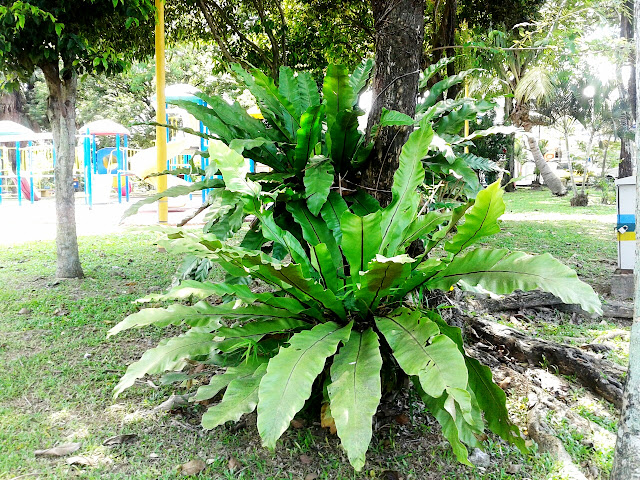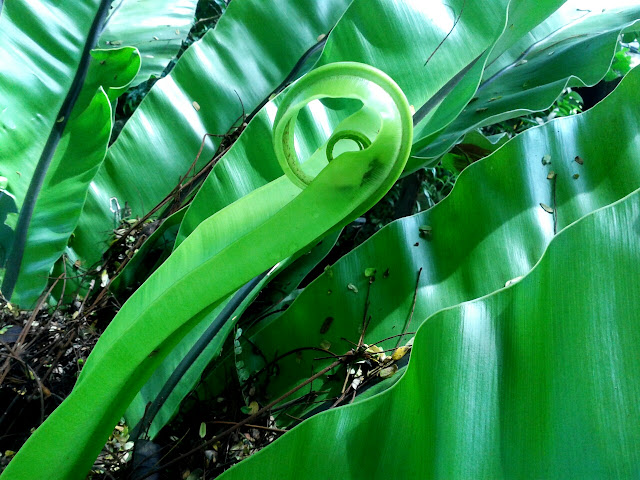1) Botany And Habitat
Asplenium nidus is a huge herbaceous epiphytic fern plant, wild growing on trees and sometimes on rocks, at elevations from sea level to 1,200 metres. The whole plant can grow to a height of 1 metre. Its entangled rhizome is a mass of roots below. Leaves are erect and flaring from the crown aggregated in a dense tuft above. Leaves are broad and numerous, radiating from the center of the plant giving the appearance of a bird's nest; spiral, leathery, smooth, lance-shaped with entire margins, sharply pointed tips and broad bases. They often attain a large size, 40 to 120 centimeters long, 6 to 20 centimeters wide. Sori are numerous, elongate running along the line of the veinlets, reaching from the midrib about halfway to the margins. Spores are bilateral, monolete with a perispore.
 |
| In Malaysia, Bird's Nest Ferns are usually found wild growing on trees in the jungle or felled tree stumps like this. |
 |
| In their natural habitat, Bird's Nest Fern feeds on nutrients that are assimilated from decayed fallen leaves or twigs accumulated at its center. |
2) Geography
The plant is native to East tropical Africa, Eastern Asia ( Japan and Taiwan ) through tropical Asia ( Eg.: Malaysia ) to northern Australia and the Pacific Islands.
3) Cultivation
It is also cultivated as an ornamental house and landscape plant.
 |
| In Malaysia, Bird's Nest Ferns are very often cultivated as ornamental house or landscape plants. One can easily purchase them from a plants nursery throughout the country. |
4) Edible Uses
- Leaves are parboiled and eaten by aboriginal tribe in Malaysia. In Taiwan, sprouts are eaten as vegetable.
- Ash from the burnt leaves can be used as a salt substitute
 |
| Young leaves ( Curled Leaves ) like this can be harvested and eaten as vegetables |
5) Folklore
- The plant has been reported to be depurative (purifying) and sedative.
- Plant has been used for halitosis.
- The Malay used a decoction of leaves to ease labor pains; also, lotion from pounded leaves in water used as poultice to the head to relieve fever.
- In French Polynesia, used for stings and bites, contraception, chest pains and lice.
- In Hawaii, shoots used for general weakness, ulcers, and sores. Also, plant is part of an asthma regimen, mixed and pounded together with flowers of ki, mixed with poi made from kalo or uala (Ipomoea batatas).
- Shoots used for general debility, sores, ulcers.
- In Taiwan, used to treat fever; infusion used to alleviate labor pains, asthma, debility, halitosis, and sores.
- In North Eastern India, rootstock used against fever and elephantiasis. Also, used as emollient, in coughs and diseases of the chest. Leaf is smoked to treat colds.
- In Kumaun Himalaya, Uttrakhand, India, used in splenic enlargement, urine calculus, jaundice, and malaria.
- In Madya Pradesh, used for jaundice and malaria.
Others
- Veterinary: In Papua New Guinea, leaves used as contraceptive in pigs.
6) Known Hazards
Although there are no reports of toxicity for this species, a number of ferns contain carcinogens so some caution is advisable. Many ferns also contain thiaminase, an enzyme that robs the body of its vitamin B complex. In small quantities this enzyme will do no harm to people eating an adequate diet that is rich in vitamin B, though large quantities can cause severe health problems. The enzyme is destroyed by heat or thorough drying, so cooking the plant will remove the thiaminase
7) Propagation
Seed ( Spore ) Or Division.
 |
| Bird's Nest Ferns can be propagated by scraping off matured spores from the underside of the leaves ( fronds ) and spreading them onto frequently misted compost soil for germination. |

No comments:
Post a Comment